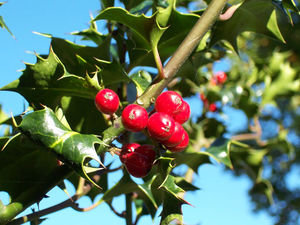Holly
Holly timber is a very hard dense fine grained hardwood, and the whitest of all timber species. Its also felled in many gardens in the UK. The interest in recycling & reuse and the rising price of timber may motivate some to re-use felled wood. This is especially true for holly, a timber with a unique appearance and very high price tag.
Qualities
Holly is a creamy white colour like no other timber.
Holly is extremely fine grained, making it an excellant canidate for turning.
Holly is hard and thus difficult to work. It glues and screws well, but holes should be drilled slowly.
Holly takes a high polish, it stains well, and can be ebonised.
Issues
Holly has significant issues. It warps a lot during drying, making pieces of a fair size hard to come by.
Holly also is prone to fungus staining after felling, which is disfiguring. To avoid this it must be dried quickly.
Holly is not recommended for outdoor use due to its vulnerability to fungus.
The final issue is that most garden felled hollies are small. This much limits the possible applications, but in the case of holly even 2" trunks have their uses.
Uses
Holly is used as a creamy white inlay veneer, where its colour is unmatched by any other wood.
Its also a good wood for turning, with its fine grain and toughness taking detail very well, and its eye catching colour.
Small sized garden holly is well suited to producing handles & knobs.
It can also of course be used in other tasks where its qualities are less important. Its high strength makes even very small trunks usable in the round for some applications.
Lastly small branches and even twigs can be used in the round for lattice-like panel infill, to make writing pens, or for Twig Furniture.
History
Historically holly was used for chariot axles, food skewers and wooden printing blocks, all applications benefitting greatly from its hardness. It was also used in Victorian looms; it sands to a very smooth surface, minimising the risk of thread catching.
Identification
Holly is easily identified by the spiky waxy leaves associated with christmas. Only female trees bear the red berries.
Drying
Holly discolours very quickly once felled. Grey, blue and green staining ruins its creamy white appearance if not processed correctly.
To retain good colour, holly should be dried as fast as possible. The way to get consistently pure creamy white timber is to debark the wood and get it into a vacuum kiln the same day its felled. For large trees this may be worth the DIYer's while, but for small ones drying at home is more realistic.
Home drying should use any means available to dry the timber as quickly as possible. Options include use of a dehumidifier, bringing the wood indoors, and use of a fan to speed drying.
Holly is a notoriously unstable wood, and fast drying only exacerbates the problem. The inevitable result is a high percentage of warped wood. To reduce warping, the cut wood is stacked and clamped with weights during drying. Layers of timber and weights should sit on small sticks so as not to impede airflow. The sticks should be of a light coloured timber so as not to stain the holly.
Small garden trees, eg 3-4" trunks, may be dried after being cut in half.
Debarking is usually done with a draw knife. A filling knife can be used instead if necessary.
